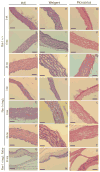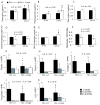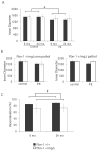Fibrillin-1 genetic deficiency leads to pathological ageing of arteries in mice
- PMID: 21432852
- PMCID: PMC3075583
- DOI: 10.1002/path.2840
Fibrillin-1 genetic deficiency leads to pathological ageing of arteries in mice
Abstract
Fibrillin-1, the major component of extracellular microfibrils that associate with insoluble elastin in elastic fibres, is mainly synthesized during development and postnatal growth and is believed to guide elastogenesis. Mutations in the fibrillin-1 gene cause Marfan syndrome, a multisystem disorder characterized by aortic aneurysms and dissections. The recent finding that early deficiency of elastin modifies vascular ageing has raised the possibility that fibrillin-1 deficiency could also contribute to late-onset pathology of vascular remodelling. To address this question, we examined cardiovascular function in 3-week-old, 6-month-old, and 24-month-old mice that are heterozygous for a hypomorphic structural mutation of fibrillin-1 (Fbn1{+/mgΔ} mice). Our results indicate that Fbn1{+/mgΔ} mice, particularly those that are 24 months old, are slightly more hypotensive than wild-type littermates. Additionally, aneurysm and aortic insufficiency were more frequently observed in ageing Fbn1{+/mgΔ}$ mice than in the wild-type counterparts. We also noted substantial fragmentation and decreased number of elastic lamellae in the aortic wall of Fbn1{+/mgΔ} mice, which were correlated with an increase in aortic stiffness, a decrease in vasoreactivity, altered expression of elastic fibre-related genes, including fibrillin-1 and elastin, and a decrease in the relative ratio between tissue elastin and collagen. Collectively, our findings suggest that the heterozygous mgΔ mutation accelerates some aspects of vascular ageing and eventually leads to aortic manifestations resembling those of Marfan syndrome. Importantly, our data also indicate that vascular abnormalities in Fbn1{+/mgΔ} mice are opposite to those induced by elastin haploinsufficiency during ageing that affect blood pressure, vascular dimensions, and number of elastic lamellae.
Copyright © 2011 Pathological Society of Great Britain and Ireland. Published by John Wiley & Sons, Ltd.
Conflict of interest statement
Authors declare no conflict of interest.
Figures






References
-
- Belz GG. Elastic properties and Windkessel function of the human aorta. Cardiovasc Drugs Ther. 1995;9:73–83. - PubMed
-
- Faury G. Function-structure relationship of elastic arteries in evolution: from microfibrils to elastin and elastic fibres. Pathol Biol (Paris) 2001;49:310–325. - PubMed
-
- Kielty CM, Sherratt MJ, Shuttleworth CA. Elastic fibres. J Cell Sci. 2002;115:2817–2828. - PubMed
Publication types
MeSH terms
Substances
Grants and funding
LinkOut - more resources
Full Text Sources
Other Literature Sources
Medical
Molecular Biology Databases

